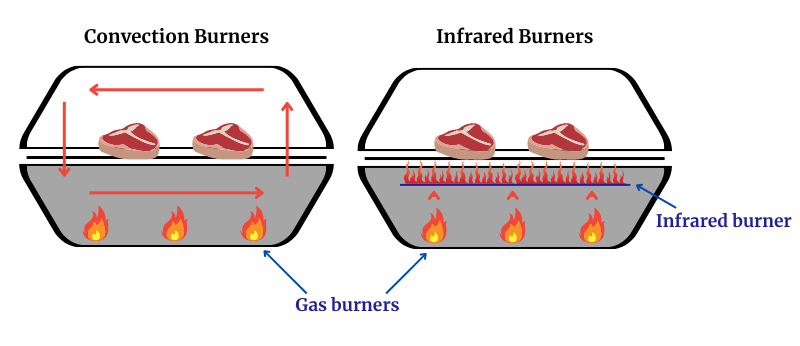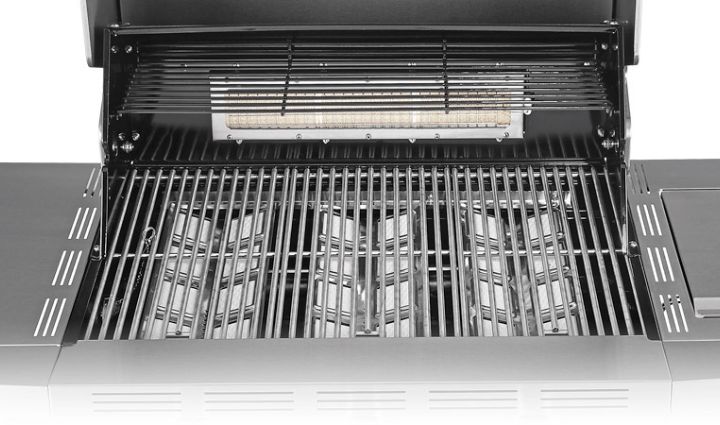Infrared grilling offers benefits like super high heat output and faster cooking times, but it also poses challenges such as limited versatility for low-temperature cooking.
When it comes to grilling, the sizzle of gas or the smoky allure of charcoal are often the first two options that come to mind. Pellet and ceramic grills are also popular amongst backyard grillers, but there’s another style of type that’s worth considering as well—the infrared gas grill.
So, what exactly is infrared grilling? We’ll get straight to it, covering all the basics you need to know about infrared grilling, including:
- What is infrared grilling?
- How do infrared gas grills work?
- Types of infrared burners
- Infrared grills pros and cons
- Hybrid grills
Let’s get grilling.
What is Infrared Grilling?
Infrared grilling uses infrared technology as a primary radiant heat source, or as an optional burner. Infrared grills are powered by gas or natural gas, so how do they differ from a traditional gas grill?
In a traditional gas grill, the flame heats the grill grates directly, and your food is cooked by convection. In an infrared gas grill, there is a special infrared element typically composed of ceramic, metal, or glass, separating the flame from the grates. The flame heats the element, which then radiates intense heat straight on to your food—no convection required.
How Do Infrared Grills Work?
Time for a science lesson! (With an assist from howstuffworks.com.)
Infrared waves are part of the electromagnetic spectrum, nestled somewhere between visible light waves and microwaves. At certain wavelengths in the infrared range, these waves will create heat.
Infrared heat is present to some degree in every type of grill, including charcoal, ceramic, pellet, and gas grills. As the temperature of the grill increases, it emits more infrared heat.
But how exactly do infrared grills harness the power of infrared heat?
When you cook or grill on any type of barbecue, your food is surrounded by a moisture boundary consisting of air and water. Conventional gas grills use gas burners to heat the grill grates and create convection currents that heat the air around whatever you’re cooking. Infrared gas grills, on the other hand, use gas burners to heat a secondary infrared burner. This infrared burner heats the meat directly—not the air around it. Because it doesn’t disturb this moisture boundary in the same way, your food will retain more of its own moisture and you’ll get tender, juicier results.

Types of Infrared Burners
There are three main types of infrared burner: Ceramic, radiant glass panels, and metal heat emitters. Let’s take a closer look at these options:
1. Ceramic infrared burners
Ceramic infrared burners are the most common type of infrared burner. In this configuration, a stainless steel burner is topped with a ceramic surface and the cooking grid sits a few inches above the ceramic. The ceramic surface produces many tiny flames that heat up ultra-fast, reaching an expected temperature range between 600 and a sizzling hot 1,000 degrees fahrenheit. This makes ceramic infrared burners perfect for searing, but not ideal for lower temperature cooking.
Ceramic burners are particularly known for their even heat distribution—the ceramic plates absorb the heat and emit it evenly, reducing hot spots and ensuring uniform cooking. And since they’re made of ceramic, they’re resistant to corrosion and require less maintenance than metal heat emitters.
2. Radiant glass panels
Radiant glass panels were introduced by TEC, the original creator of infrared grills. In this configuration, the cooking grid is positioned directly atop a tempered glass panel that sits over a stainless steel burner. These types of infrared burners can reach heats between 200 and 900 fahrenheit—not quite as hot as ceramic, but still hot enough to get a delicious crusty sear.
3. Metal heat emitters
This style of infrared grill features a stainless steel tube burner with a perforated metal heat emitter sheet sitting over top, and a cooking grid directly above the emitter panel. They can reach temperatures between 300 and 650—about the same as a traditional gas grill—but an infrared burner will reach these temps much faster. Metal heat emitters are the least powerful type of infrared burner, but they’re still hot enough to sear and offer the versatility to cook more delicate items as well.
Infrared Grills: Pros and Cons
Infrared gas grills offer a number of benefits, but they have their drawbacks as well. Let’s explore the pros and cons of infrared grills.
Pros
- Higher temperatures: Infrared grills can reach much higher temperatures than other gas grills, and even charcoal grills. This makes them great for searing and creating that much-desired Maillard reaction.
- Fast heating: Infrared grills can reach ultra-high temperatures in as little as 3-5 minutes. They also retain heat better, even when you open the lid.
- Quick cooking: Capable of reaching much higher temps than other gas grills, you can cook a steak in as little as one minute per side on an infrared grill.
- Even heating: Infrared burners distribute heat more evenly than traditional burners, with fewer hot (or cold) spots to work around.
- Fewer flare ups: Anything that drips from your meat will vaporize instantly the second it hits the infrared burner. That means less mess to clean up when you’re done!
- More fuel efficient: Because the flame isn’t exposed to air (and therefore less heat is lost), less fuel is required to reach higher temps.
Cons
- Not ideal for lower temperatures: If you like to smoke, cook low and slow, or just use medium or indirect heat, infrared grills will not be your friend.
- Higher cost: Infrared grills can easily cost over $1,000, but smaller grills at a mid-range price point are available, as are lower cost portable options. Considering that infrared grills aren’t ideal for lower temperature cooking, the price point can quickly become prohibitive, especially if you cook at lower temps more often and need a second grill.
- Technique: Since they reach much higher temperatures, there’s a bit of a learning curve when it comes to using an infrared grill properly. Until you get the hang of balancing heat and cooking time, it’s much easier to burn your food or end up with a perfect crusty edge with an undercooked center.
- Less versatility: While infrared grills excel at high-heat cooking techniques like searing, they are not as versatile as traditional grills for low-and-slow cooking methods such as smoking or indirect grilling.
Hybrid Grills: The Best of Both Worlds
Hybrid grills feature infrared technology in addition to traditional gas grill burners. Some hybrid grill models will include an infrared side burner, or even an infrared rotisserie burner.
With a combination of traditional convection burners and an infrared burner zone, hybrid grills can easily be set up to create dual cooking zones, allowing you to sear foods over high infrared heat, then finish cooking them over lower temps. With this versatility, you can switch between traditional gas grilling for low-and-slow cooking or indirect heat, and harness the intense heat of infrared technology to get that perfect sear.
Get Grilling
In this post, we’ve delved into the fundamentals of infrared grilling, from its underlying technology to the various types of infrared burners available in the market.
Infrared gas grills offer distinct advantages, including high heat output, faster cooking times, even heat distribution, and reduced flare-ups. But they also come with some drawbacks, such as a higher initial cost, a learning curve for optimal usage, and limited versatility for lower-temperature cooking methods.
Whether you’re a seasoned grilling aficionado or a newcomer to the world of outdoor cooking, exploring the possibilities of infrared grilling can add a new dimension of flavor and excitement of your culinary adventures.

